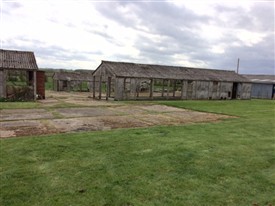POWs in Caunton

The sheds at Caunton today (2015)
T.Frecknall
During the Second World War Italian POWs were held in premises on the road to Bathley. Some of the wooden sheds in which they were housed still survive (2014) and are used for storage.
The picture right has been sent in by Trevor Frecknall of Bathley, who writes:-
"As you see, only two of the prison blocks are still standing and they are skeletal after all these decades on a windswept hillside. They were built of such flimsy wood, it's astonishing they lasted as long as the Second World War. But you can also still see the concrete bases of the other cell blocks".
If you can provide any more information about this topic (including photos), please leave a 'Comment' via the link below. Thank you